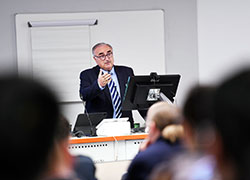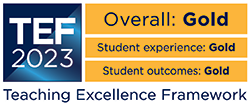Teesside continues to perform well
More young first year full-time students are staying on at Teesside University, according to official government figures out this week.
The number at Teesside continuing or qualifying after their first year at university is up from 87% in 2005/6 to 87.8% in 2006/07. This compares with a fall of 0.3% nationally for all UK universities.
The annual Performance Indicators from the Higher Education Statistics Agency (Hesa) look at completion and continuation rates as well as the changing social mix of university students up and down the country.
The biggest improvement at Teesside was in first-year students, one of the groups seen at most risk of failing to continue their studies.
We are never complacent Professor Caroline MacDonald, Teesside University’s Deputy-Vice-Chancellor (Learning and Student Experience), said: 'We are encouraged that many of these indicators are moving in the right direction. But we are never complacent!
'We are always looking to see how we can improve our support for students, particularly the initial experience of students arriving from school or college and also for the many mature students we have here at Teesside.
'We know students can find it difficult to adjust to the different approach to learning at university and to the adaptations they need to make to their lifestyle, particularly if they have family and other commitments like a part-time job.'
Professor MacDonald also voiced concern about describing students as ‘drop-outs’ when they may, for example, just defer completing their final year. 'Sometimes students have to leave us after say two years because of family circumstances but they still leave with a qualification and can return to complete their degree at a later time. They have postponed their final year rather than dropped-out completely, but the figures don’t reflect this.'
More Teesside students are also forecast to finish their full-time degree courses at Teesside within the set time period, with the number of positive outcomes up from 84.3% to 84.7% - this is in line with a 0.4% increase nationally.
Professor MacDonald said: 'The Performance Indicators are very useful in monitoring how we are doing as a University in terms of widening participation and how we are performing against the benchmarks calculated for us by the Government’s Higher Education Statistical Agency – HESA.'
These benchmarks take account of the type of university we are in terms of our student intake and the range of courses we offer.
'It is interesting, for example, that our benchmark for students leaving with 'neither award nor transfer' is 19.5%, but that the actual figure in the performance indicators for us is much better at 15.3%, a 0.4% improvement on the year before.
'So, more first years are continuing with their studies with us and achieving a qualification or transferring to complete their studies at another institution.'
As for the social make-up of students, Teesside’s figures are not exactly following the national trend, which show the number of state school students is creeping up overall. In Teesside’s case, the number of young full-time degree entrants from state schools actually fell from 99.1% to 98.9%; a but it is such a high figure to start with that Teesside will remain one of the best universities for encouraging state school pupils to enter higher education.
'Our benchmark for taking young full-time undergraduate entrants from state school colleges is 94.4%, but we’ve more than beaten that and are ten per cent ahead of the national figure for all UK universities.'
The number of students from low participation neighbourhoods in higher education is up once again at Teesside, from 25.3% to 26.6%, and well ahead of the national average which remains under 10% despite government efforts to encourage more people to go to university from all backgrounds.
 Teesside University hosts groundbreaking hydrogen conference
Teesside University hosts groundbreaking hydrogen conference University supporting development of new £1m concrete plant
University supporting development of new £1m concrete plant Academic’s artwork on display at Middlesbrough station
Academic’s artwork on display at Middlesbrough station